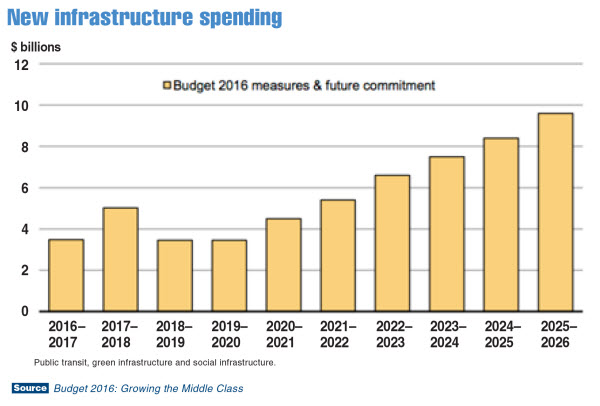By Mike Kastner, NTEA Managing Director
This article was published in the May 2016 edition of NTEA
News.
Recently, Canadian Finance Minister Bill Morneau
presented the government’s highly anticipated Budget 2016: Growing the
Middle Class in the House of Commons. The new budget supports an ambitious
agenda that seeks to fulfill key election promises and will see new federal
investments in everything from infrastructure, to the creation of the Canadian
Child Benefit, to re-engaging indigenous communities. The Liberal Party’s
campaign promise of keeping budget deficits to below $10 billion was not kept,
with the projected deficit now at $29.4 billion.
Following is a closer look at provisions relevant to the
work truck industry: infrastructure, energy and mining.
Infrastructure
One of
Budget 2016’s largest expenditures is infrastructure, with plans to
invest more than $120 billion over the next 10 years, divided into two phases.
The first concentrates on Canada’s short-term needs (e.g., upgrading public
transit, allotting funds for wastewater facilities, etc.) with investments
totaling $11.9 billion over five years and set to begin immediately.
The second phase concentrates on Canada’s long-term
infrastructure needs to help create a more modern economy better positioned to
capitalize on global trade. Investments will focus on making Canada’s largest
cities better places to live through cost-effective, sustainable and integrated
transportation networks. This will also create fast and efficient corridors to
help Canadian exporters benefit fully from international trade. Noteworthy
investments include:
- $3.4 billion over the next five
years, on a cash basis, to maintain and upgrade federal infrastructure assets
such as airports and border infrastructure
- Approximately $3 billion each
year in dedicated funding for municipal infrastructure projects through the Gas
Tax Fund and the Goods and Services Tax Rebate for Municipalities
- $9 billion available under New
Building Canada Fund’s Provincial-Territorial Infrastructure Component and other
existing infrastructure programs
- $3.4 billion in public transit
over three years, starting in 2016 to 2017. Funding will be provided through a
new Public Transit Infrastructure Fund
- Continued investment toward
construction of the Gordie Howe International Bridge project between Windsor,
Ontario, and Detroit, Michigan, including requests-for-proposals to select
private-sector partners for construction and ongoing operation of the new
crossing

Energy
Canada’s energy sector,
particularly Alberta oil sands, has been hit hard by the drop in global oil
prices, high labor costs and constraints on infrastructure to move the product
to market (i.e., pipelines). Most energy-related commitments in Budget
2016 pertain to increased investment in green and renewable energy
technologies to spur energy-sector diversification and combat climate change.
New spending includes:
- $82.5 million over two years to
Natural Resources Canada to support the research, development and demonstration
of clean energy technologies
- $128.8 million over five years
to Natural Resources Canada to deliver energy efficiency policies and programs
to support improved energy efficiency standards and codes for products,
buildings, industry and vehicles
- $56.9 million over two years to
Transport Canada and Environment and Climate Change Canada to support the
transition to a cleaner transportation sector, including the development of
regulations and standards for clean transportation technology
- $62.5 million over two years to
Natural Resources Canada to support infrastructure deployment for alternative
transportation fuels, including electric vehicle charging and
natural gas
and hydrogen refueling stations.
Mining
Canada heavily relies
on its resource extraction and export sector. Although this budget looks toward
new industries and technologies, it also builds on Canada’s strengths in more
traditional segments. Key investments for this area:
- One-year extension of the
15-percent Mineral Exploration Tax Credit. This helps junior mineral exploration
companies raise capital by providing an incentive to individual investors in
flow-through shares issued to finance “grassroots” mineral exploration
- $1 billion over four years to
support clean technology, including in the forestry, fishery, mining, energy and
agriculture sectors (specific details are being provided through the
government’s Innovation Agenda).
Motor vehicle safety
Motor
vehicle safety is one of the priority regulatory areas NTEA monitors and on
which it engages policymakers. Budget 2016 proposes $7.3 million over two
years to increase inspection capacity and support development of a regulatory
framework for emerging technologies, such as automated vehicles.
Looking ahead
The new budget
presents a dramatic shift from the previous government. The last time Canada
projected double-digit deficits was after the 2008 financial crisis when
then-Minister of Finance Jim Flaherty engaged in heavy deficit spending through
stimulus packages. The Liberal government has promised to continue reducing the
debt to GDP (gross domestic product) ratio, while running deficits for all four
years of their mandate.
As the details surrounding specific initiatives are
released, NTEA’s government relations office in Ottawa, Ontario, will continue
to follow key developments.
If you have any questions regarding the information in this article,
please contact Mike Kastner at 202-552-1600 or mkastner@ntea.com.